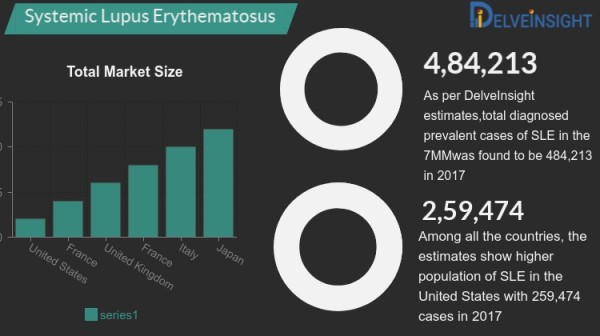
(Albany, US) DelveInsight has launched a new report on Systemic Lupus Erythematosus Epidemiology Forecast to 2030
DelveInsight’s Systemic Lupus Erythematosus Epidemiology Forecast to 2030 report delivers an in-depth understanding of the disease, historical and forecasted Systemic Lupus Erythematosus epidemiology in the 7MM, i.e., the United States, EU5 (Germany, Spain, Italy, France, and the United Kingdom), and Japan.
The Systemic Lupus Erythematosus market report provides current treatment practices, emerging drugs, Systemic Lupus Erythematosus market share of the individual therapies, current and forecasted Systemic Lupus Erythematosus market Size from 2017 to 2030 segmented by seven major markets. The Report also covers current Systemic Lupus Erythematosus treatment practice/algorithm, market drivers, market barriers and unmet medical needs to curate best of the opportunities and assesses the underlying potential of the market.
According to the American College of Rheumatology “Systemic lupus erythematosus, ( SLE, Lupus) is a chronic (long-term) disease that causes systemic inflammation which affects multiple organs. In addition to affecting the skin and joints, it can affect other organs in the body such as the kidneys, the tissue lining the lungs (pleura), heart (pericardium), and brain. Many patients experience fatigue, weight loss, and fever. Lupus flares vary from mild to severe. SLE is most commonly seen in women in the reproductive age group (frequently starting at childbearing age), although lupus is increasingly recognized after the age of 40 years, particularly in the Europeans.
The cause of lupus in most cases, however, is unknown. Some potential triggers include sunlight, genetic link, infections, and medicines.Common symptoms of SLE include tiredness, joint pain or swelling, fever, skin rash, mouth sores, and hair loss. In childhood-onset SLE, there are several clinical symptoms more commonly found than in adults, including malar rash, ulcer, renal involvement, proteinuria, seizures, thrombocytopenia, hemolytic anemia, fever, and lymphadenopathy. The diagnosis of systemic lupus erythematosus is based on clinical and laboratory criteria, however, SLE is difficult to diagnose in primary care because many of the symptoms (e.g., fatigue, rash, joint pain) are nonspecific and overlap with those of more common conditions. Furthermore, biomarkers are often negative or normal, early in the course of the illness. The most common presenting symptoms are constitutional, such as fatigue, weight loss, and fever without a focal infection, occurring in up to 90% of patients.

Click here- Free sample page
Epidemiology Perspective
The Systemic Lupus Erythematosus epidemiology division provides insights about historical and current patient pool and forecasted trend for every seven major countries. The Systemic Lupus Erythematosus epidemiology data are studied through all possible division to give a better understanding of the Disease scenario in 7MM. The Systemic Lupus Erythematosus epidemiology segment covers the epidemiology data in the US, EU5 countries (Germany, Spain, Italy, France, and the UK), and Japan from 2017 to 2030. It also helps to recognize the causes of current and forecasted trends by exploring numerous studies, survey reports and views of key opinion leaders.
Report key facts-
1. As per DelveInsight estimates,total diagnosed prevalent cases of SLE in the 7MMwas found to be 484,213 in 2017. Among all the countries, the estimates show higher population of SLE in the United States with 259,474 cases in 2017
2. Among the EU5 countries,UK had the highest diagnosed prevalent population of SLE with 62,852cases, followed by Italy in 2017. On the other hand, Spain had the lowest prevalent population.
3. According to DelveInsight estimates,among the 7MM, Japan had the lowest diagnosed prevalent population of SLE in 2017.
Some of key companies are working on this disease which are given below-
1. GlaxoSmithKline Co.
2. Merck KGaA Co.
3. Immupharma Co.
Name of drugs covered that are given below-
1. Atacicept
2. Lupuzor
3. Baricitinib
1. Key Insights
2. Executive Summary of Systemic Lupus Erythematosus
3. Systemic Lupus Erythematosus: Disease Background and Overview
4. Patient Journey
5. Epidemiology and Patient Population
6. Treatment Algorithm, Current Treatment, and Medical Practices
7. KOL Views
8. Unmet Needs
9. Appendix
9.1. Bibliography
9.2. Report Methodology
10. DelveInsight Capabilities
11. Disclaimer
12. About DelveInsight
Why should you buy this report?
- The Systemic Lupus Erythematosus Epidemiology report will allow the user to –
- Develop business strategies by understanding the trends shaping and driving the global Systemic Lupus Erythematosus market
- Quantify patient populations in the global Systemic Lupus Erythematosus market to improve product design, pricing, and launch plans
- Organize sales and marketing efforts by identifying the age groups and sex that present the best opportunities for Systemic Lupus Erythematosus therapeutics in each of the markets covered
- Understand the magnitude of Systemic Lupus Erythematosus population by its epidemiology
- The Systemic Lupus Erythematosus Epidemiology Model developed by DelveInsight is easy to navigate, interactive with dashboards, and epidemiology based with transparent and consistent methodologies. Moreover, the model supports data presented in the report and showcases disease trends over 11-year forecast period using reputable sources.
Related Reports:-
1. Systemic Juvenile Idiopathic Arthritis (SJIA) – Epidemiology Forecast to 2030
2. Systemic Mastocytosis – Epidemiology Forecast to 2030
Media Contact
Company Name: DelveInsight Business Research LLP
Contact Person: Yash Bhardwaj
Email: Send Email
Phone: +919650213330
Address:304 S. Jones Blvd #2432,
City: Las Vegas
State: NV
Country: United States
Website: https://www.delveinsight.com/

